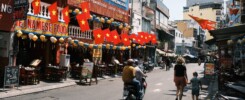As a coffee lover, I was looking forward to learning about coffee culture in different countries on our tour. In Vietnam, I finally found what I had been looking for: K’Ho Coffee is a speciality roaster based on a coffee farm in Da Lat. They offer workshops that include processing, sample roasting, grading, and cupping of their different coffees. Rolan, a highly impressive woman of the K’Ho ethnic minority group, knows her coffee business inside out and aspires to produce world-class Arabica coffee in a country where the vast majority of beans is of the Robusta type. In Vietnam, interestingly, both coffee and tea play an important role. While we could divide the world into tea countries and coffee countries, here you have both. Tea is served with most meals instead of water (tap water is not a thing here), whereas coffee is served in all different shapes and flavours in cafés as well as in the streets. You can have hot coffee, iced coffee, coconut coffee, egg coffee, and salt coffee, to name a few. And while all these local specialties are truly delightful, I am looking forward to bringing home the beans we roasted in Rolan’s coffee shop and making some nice cold brew.
Speaking of culinary delights – Vietnam is every foodie’s heaven with so many aromas and textures literally around every corner. There is tropical fruit that’s hard to obtain back home but insanely delicious such as mangosteen and jack fruit, there are coconuts to quench your thirst, and there is more street food than you can possibly sample in a one-month visit. Our very first breakfast on our first day in Vietnam included iced coffee, crab soup and a huge stack of fresh herbs and sprouts meant to be rolled into rice paper and sprinkled with fish sauce. Our tastebuds rejoiced, and so did our wallets, since food in Vietnam is not only delicious, but also very affordable. Eating out appears to be deeply rooted in Vietnamese culture. Everybody is squatting on tiny plastic stools enjoying their soup – tourists and locals alike. Most places that serve breakfast Pho don’t look anything like restaurants; they are some granny’s living room with a makeshift outdoor kitchen out front and a couple of tiny tables and stools on the sidewalk. For under one euro, you can have a huge bowl of excellent homemade comfort food with more taste than tenfold the money could get you in an English-speaking country. This is something I sorely miss in the “western” hemisphere: A culture of affordable, accessible, healthy, and delicious food. Something as unpretentious and down-to-earth as a Würstelstand, but with fresh homemade food. I know, this sounds delusional, but here in communist Vietnam, it works.
After Anna’s collaborations in Saigon and Da Lat, we were in for a little leisure time. We headed down to the beach town of Nha Trang, on to Quy Nhon, and then to Hoi An, the latter of which is a super touristy, yet charming town known for its lantern-lit boats, its near-by ancient temples, and its tailors. I took my chance and treated myself to two tailored shirts for my birthday. The most unique present, however, was yet to come: an overnight train ride to Hanoi.
Vietnams railway network was established by the French around 1900. Stations are called “Ga” and the timetable for the entire country fits on one page. The “Reunification Express” connects Saigon to Hanoi, a distance of 1726 kilometres that takes around 30 hours to complete. The longest leg we took was the 18-hour journey from Hoi An to Hanoi, and we enjoyed every bit of it. In contrast to the shorter legs we had taken before, we now had our private 4-berth sleeper cabin with plenty of room. During the daylight hours, we enjoyed the varied landscape rolling by as well as the many culinary delights the train crew brought along. Since there was nothing else to do, we basically bought everything we were offered: cold beer from a Styrofoam box with ice cubes, ice cream cones from a similar box (slightly runny), a sliced mango with salt in a plastic bag, Bánh Mì sandwiches, more beer, and finally, for dinner, Com Ga, chicken with rice as well as pork belly with rice, pickles, and soup, neatly organised on plastic trays. Happy birthday!
After a good nights’ sleep, we arrived in Hanoi, and yes, the famous train street is real. These are actual passenger trains running through an alley that would be considered narrow anywhere else, just that in Vietnam, there is always enough space for an extra couple of tables and chairs, vendors, ceremonial fires, motor scooters, and boatloads of people. Plus full-sized trains. As usual in this country, nobody knows how, but everything somehow works.







































